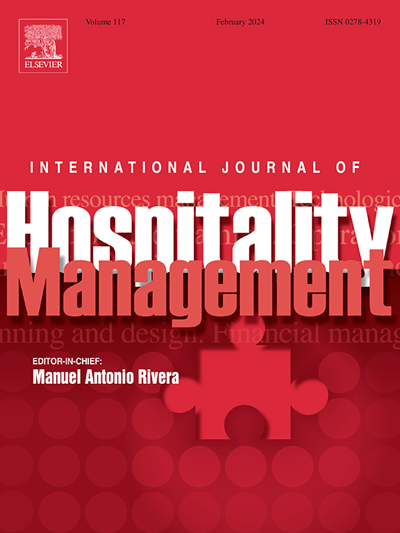Mystery as a luxury service brand signal on social media
IF 8.3
1区 管理学
Q1 HOSPITALITY, LEISURE, SPORT & TOURISM
International Journal of Hospitality Management
Pub Date : 2025-10-16
DOI:10.1016/j.ijhm.2025.104468
引用次数: 0
Abstract
Luxury services marketers face a tension between the openness of social media and the need to keep the sense of mystery that underpins luxury service experiences. This study investigates mystery as a signal of luxury focussing on how Michelin star restaurants use mystery appeals in their social media marketing strategies. Employing a qualitative approach, the research firstly analyses a series of semi-structured interviews with social media managers from Michelin star restaurants, and secondly examines content posted on their official social media accounts. We identify six types of mystery appeals: minimalism, prestige, superiority, identity, exclusivity, and co-creation, representing different levels of information disclosure, which either reduce or preserve information asymmetry, as a mechanism for signalling luxury status. Low mystery signals decrease asymmetry by revealing specific aspects of the luxury service experience, informing potential consumers and influencing purchase intentions. In contrast, high mystery signals, in prolonging information asymmetry, reinforce the core tenets of luxury, such as rarity and exclusivity, which may result in prospective consumers turning to external sources that are not brand-controlled. Building on these insights, we propose a theoretical framework illustrating the iterative nature of the usage of the six proposed mystery appeals to manage information asymmetry. This paper extends the growing literature on luxury services, social media marketing and signalling theory, while also offering practical implications for practitioners and highlighting future research avenues.
神秘感作为奢侈服务品牌在社交媒体上的信号
奢侈品服务营销人员面临着一种矛盾,一方面是社交媒体的开放性,另一方面是保持奢侈品服务体验的神秘感。这项研究将神秘感作为奢侈品的标志,重点关注米其林星级餐厅如何在其社交媒体营销策略中使用神秘感。该研究采用定性方法,首先分析了对米其林星级餐厅社交媒体经理的一系列半结构化访谈,然后研究了他们在官方社交媒体账户上发布的内容。我们确定了六种类型的神秘诉求:极简主义、声望、优越感、身份、排他性和共同创造,代表了不同程度的信息披露,这些信息披露减少或保留了信息不对称,作为一种表明奢侈品地位的机制。低神秘感信号通过揭示奢侈品服务体验的特定方面,告知潜在消费者并影响购买意愿来减少不对称性。相反,高度神秘的信号在延长信息不对称的过程中,强化了奢侈品的核心原则,如稀有性和排他性,这可能导致潜在消费者转向不受品牌控制的外部来源。在这些见解的基础上,我们提出了一个理论框架,说明了六个提出的神秘呼吁用于管理信息不对称的迭代性质。本文扩展了奢侈品服务、社交媒体营销和信号理论方面不断增长的文献,同时也为从业者提供了实际意义,并强调了未来的研究途径。
本文章由计算机程序翻译,如有差异,请以英文原文为准。
求助全文
约1分钟内获得全文
求助全文
来源期刊

International Journal of Hospitality Management
HOSPITALITY, LEISURE, SPORT & TOURISM-
CiteScore
21.20
自引率
9.40%
发文量
218
审稿时长
85 days
期刊介绍:
The International Journal of Hospitality Management serves as a platform for discussing significant trends and advancements in various disciplines related to the hospitality industry. The publication covers a wide range of topics, including human resources management, consumer behavior and marketing, business forecasting and applied economics, operational management, strategic management, financial management, planning and design, information technology and e-commerce, training and development, technological developments, and national and international legislation.
In addition to covering these topics, the journal features research papers, state-of-the-art reviews, and analyses of business practices within the hospitality industry. It aims to provide readers with valuable insights and knowledge in order to advance research and improve practices in the field.
The journal is also indexed and abstracted in various databases, including the Journal of Travel Research, PIRA, Academic Journal Guide, Documentation Touristique, Leisure, Recreation and Tourism Abstracts, Lodging and Restaurant Index, Scopus, CIRET, and the Social Sciences Citation Index. This ensures that the journal's content is widely accessible and discoverable by researchers and practitioners in the hospitality field.
 求助内容:
求助内容: 应助结果提醒方式:
应助结果提醒方式:


